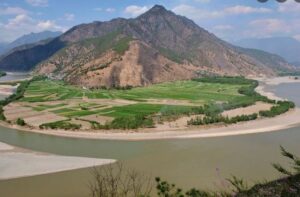 Parts of the freshwater Drishu River [Ch: Yangtze] have run dry in the drought and heatwave in China. The river’s water levels have decreased to almost a half of its normal volumn, this has not only impacted hydropower, shipping routes and trade in the country but has also put drinking water supplies for people and livestock, as well as agriculture generally, in peril.
Parts of the freshwater Drishu River [Ch: Yangtze] have run dry in the drought and heatwave in China. The river’s water levels have decreased to almost a half of its normal volumn, this has not only impacted hydropower, shipping routes and trade in the country but has also put drinking water supplies for people and livestock, as well as agriculture generally, in peril.
According to Bloomberg, temperatures above 40 degrees Celsius have been recorded in dozens of locations, and rainfall along the Drishu River since July has been 45 percent below normal, the lowest since 1961. This month, the drought has already had an impact on 350,000 animals and nearly 8,500 square miles of arable land in China, according to the country’s Ministry of Water Resources and the first nationwide drought warning in nine years was issued by the Chinese government on August 19. China is on the verge of a water crisis due to the drought, heat wave and drying up of its largest river, according to the journal Foreign Affairs, the American magazine of international relations. There is speculation that this could also result in shortages of food and industrial resources on a much larger scale than those caused by the Covid-19 epidemic and the war in Ukraine.
More than 450 million people live along the Yangtze River, which rises in the Jari Hill region in the Tanggula Mountain range in the centre of the Tibetan Plateau. Many of these people are Tibetans who have settled in the river’s upper reaches in far-flung mountainous regions. Since the majority of these people depend on the river for their water, crops and means of subsistence, they are now suffering.
The Chinese government has reportedly released water from several upstream reservoirs in response to the situation, and the Ministry of Agriculture said it would try to artificially increase rainfall through cloud seeding, as well as spraying crops with a water-retaining agent, according to Grist, a nonprofit independent media organisation that focuses on climate solutions.
The Drishu/Yangtze River passes through 11 provinces in Tibet and China, including Tibet (with Amdo and Kham in eastern Tibet), Sichuan, Yunnan, Chongqing, Hubei, Hunan, Jiangxi, Anhui, Jiangsu and Shanghai, according to the World Atlas. With a total length of more than 6,300 km, the Drishu/Yangtze River is the longest river in Asia and China, and the third-longest river in the world, behind the Nile and Amazon rivers.




 Print
Print Email
Email